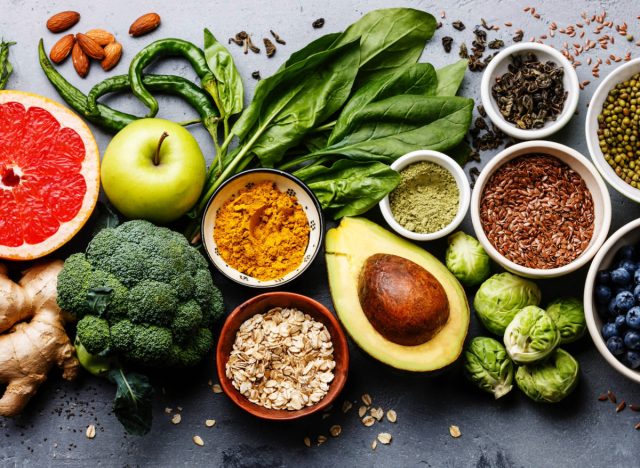There are many things to consider when trying to lose weight. One important factor to be aware of is the macros you consume, which are the nutrients that feed you energy. Basically, managing your macros means maintaining a delicate balance of the right foods in the right amounts. We’re here to let you in on all you need to learn about calculating and balancing your macros in order to optimize weight loss.
“Balancing and counting macros can be an effective strategy for weight loss when done correctly and consistently. By understanding the importance of each macronutrient and how to calculate and adjust your intake, you can tailor your diet to meet your weight loss goals effectively,” explains Amy Goodson, MS, RD, CSSD, LD, a registered dietitian and certified specialist in sports dietetics who sits on our Medical Expert Board.
We’re here to break down the macro balancing process that can take a little getting used to.
What exactly are macros?

Macros, or macronutrients, are the nutrients that give your body energy to function and perform everyday activities. The three major macros include fats, carbohydrates, and proteins—and they all play an important role in overall health.
Goodson tells us that healthy fats are essential for a healthy brain, cell membrane maintenance, and hormone production. “[Fats] also help keep you full and satisfied, which can prevent overeating,” says Goodson. “Fats, however, do yield more calories per gram (nine calories per gram versus the four calories per gram that carbohydrate and protein yield), so individuals typically do not need as much fat as carbs and protein.)”
Carbohydrates are necessary, as they’re your body’s main energy source. Carbs are broken into glucose, which helps your body function properly and successfully perform physical activities.
“Carbohydrates are crucial for providing quick energy, especially during high-intensity exercise,” explains Goodson. “They also play a role in brain function and can help regulate mood and cognitive performance, in addition to providing many B vitamins and fiber. Fiber does not digest, so it can help increase satiety after meals, helping with portion control and hunger levels.”
Last but not least, let’s discuss protein. Protein is key to muscle and tissue building and repair. It’s also necessary to produce hormones, enzymes, and other chemicals in your body.
“Protein supports muscle growth and maintenance, aids in recovery after exercise, and helps [maintain] a healthy immune system. It also has a high thermic effect, meaning it requires more energy to digest, which can aid in weight loss,” Goodson explains. “It helps individuals feel full faster and stay full longer, which can additionally help with portion control, an essential component of weight loss.”
Here’s how to calculate your macros:

Calculating your macronutrient needs is a bit involved but will help ensure you’re adjusting and consuming the right amounts of food to maximize weight loss. A calorie calculator app can be helpful, along with a log so you can record your progress.
1. Determine your needs.
The first step is to know your daily calorie requirement. This includes things like your sex, age, height, weight, and level of physical activity.
“The ‘calories per pound’ rule is a simplified method to estimate daily caloric needs for weight maintenance based on body weight. This rule uses a multiplier to estimate the number of calories needed per pound of body weight to maintain current weight, considering different activity levels,” says Goodson.
This should give you a good estimate of the calories you need to maintain your present weight. In order to lose weight, it’s recommended to establish a 500-calorie deficit per day. This is done by lowering your calorie intake from what you eat, bumping up your physical activity, or combining both.
These are the basic multipliers to determine your daily caloric needs:
- Sedentary (little to no exercise), calories per pound: 13 to 15
- Moderately active (light exercise/sports 1-3 days/week), calories per pound: 15 to 18
- Active (moderate exercise/sports 3-5 days/week), calories per pound: 18 to 20
2. Set macronutrient ratios.
The next step is establishing your macronutrient ratios based on your personal information. Goodson explains the common ratios for weight loss should fall in these percentages:
- Protein: 25-30% of total calories
- Carbohydrates: 30-40% of total calories
- Fats: 25-35% of total calories
3. Calculate the amounts of macronutrients you should consume.
- Protein: 1 gram of protein = 4 calories
- Carbohydrates: 1 gram of carbohydrate = 4 calories
- Fats: 1 gram of fat = 9 calories
Goodson’s example is that if your daily calorie requirement is 2,000 calories, and the ratio you decide on equals 30% protein, 40% carbs, and 30% fats, you can follow this formula:
- Protein: 2000 x 0.30 = 600 calories / 4 = 150 grams
- Carbohydrates: 2000 x 0.40 = 800 calories / 4 = 200 grams
- Fats: 2000 x 0.30 = 600 calories / 9 = 67 grams
Tips for balancing your macros for weight loss:

Once you determine how much of each nutrient you should have to achieve your weight-loss goals, these are some easy tips to be mindful of.
1. Make sure to include enough protein.
This will help maintain muscle health and keep you feeling full. “It’s important to consume protein at each meal and snack to help manage hunger and fullness, as well as portion control,” Goodson stresses. “Ideally, make one-fourth of your plate lean protein at each meal.”
2. Monitor your carbs.
Opt for complex carbs, including fruits, vegetables, and whole grains. You want to choose these rather than simple sugars to keep your energy levels strong and avoid spikes in blood sugar. Goodson recommends filling up one-fourth of your plate with high-fiber carbs for every meal.
3. Load up on non-starchy vegetables.
Load your plate with non-starchy vegetables. Goodson recommends, “Include colorful vegetables like broccoli, yellow squash, zucchini, asparagus, red bell peppers, carrots, etc. at as many meals as you can. Ideally, make one-half of your plate non-starchy vegetables at each meal for more fiber and [fewer] calories.”
4. Use healthy fats as a garnish.
Healthy fats such as nuts, avocados, seeds, and olive oil are a perfectly healthy garnish to your meals. They also help you feel full. “Think of adding them like a garnish on a plate at a restaurant,” says Goodson.

